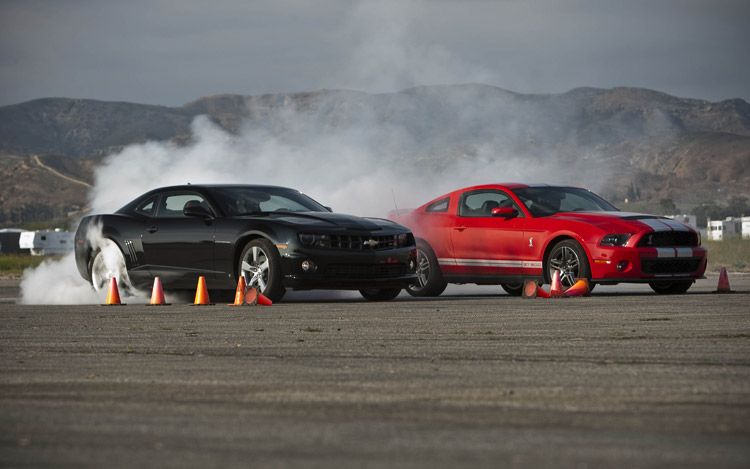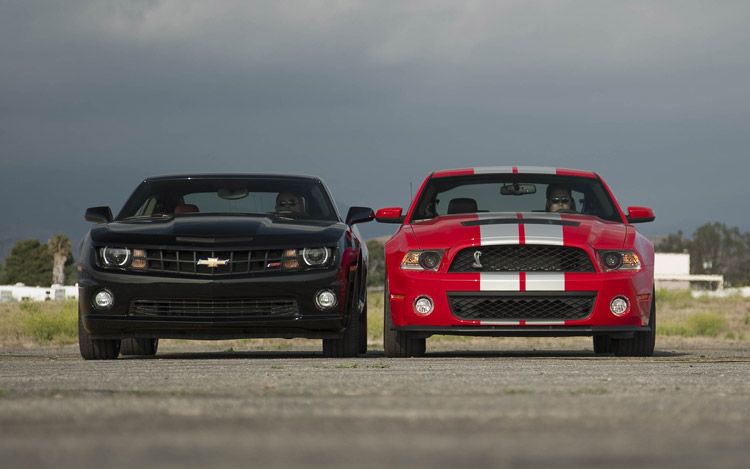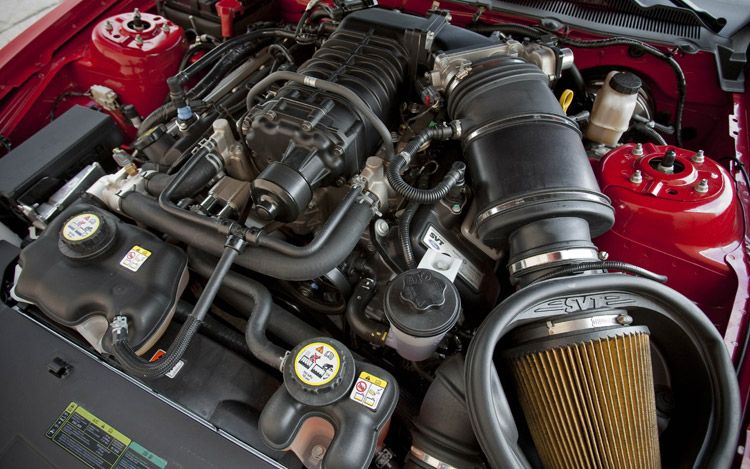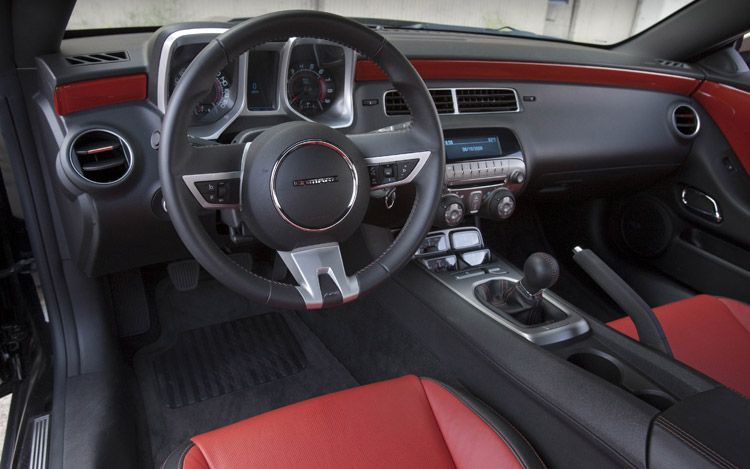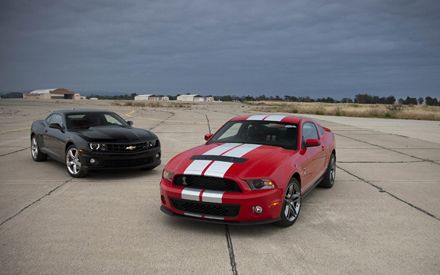Review: 2010 Ford Shelby GT500 vs 2010 Chevrolet Camaro SS
“Not fair!” howled a bunch of Ford fans when we pitted the 2010 Mustang GT against Chevy’s new Camaro, and it lost. “What about the Shelby GT500? You should be comparing the top-of-the-range Camaro with the top-of-the-range Mustang.”
Hey, it’s not our fault Ford brought a knife to a gunfight. The simple truth is you can buy a 426-horsepower Camaro for the same money as a 315-horsepower Mustang. In fact, order a GT Premium with the TrackPack — the only way to get the GT500-inspired suspension upgrades, 3.73 rear axle, dual-piston front calipers, recalibrated stability control system, plus the 19-inch wheels and tires that make the 2010 Mustang such a blast through the twisties — and you’ll pay about 1500 bucks more than you would for a 1SS-spec Camaro, which comes standard with Pirelli tires, Brembo brakes, a six speed manual transmission, and a 21st-century rear suspension.
Look at the price, look at the market positioning: The Mustang GT’s logical rival is the faster, more powerful, more refined Camaro SS. End of argument.
But the Ford faithful got us thinking: With the 556-horse supercharged Z/28 on indefinite hold, the SS is the toughest factory Camaro you can buy. Is it good enough to take on the new 540-horse 2010 Shelby GT500? Or does Ford now own the high ground in a ponycar war that has ebbed and flowed between these two automakers for more than 40 years now? We decided to find out.
First, we corralled a 2SS Camaro manual with the optional RS package (the giveaway is the red SS badging). It’s mechanically identical to the $30,995 1SS we tested earlier, but a bunch of appearance and luxury extras, including a sunroof, boost the price tag to $37,250. We’ve covered the new GT500 in detail already. Base price is $48,175, but our tester came equipped with Ford’s Electronics Package — essentially nav and dual-zone air-conditioning — plus HID headlights, pushing the sticker to $50,985.
You want bang-for-buck barroom bragging rights? The Camaro SS nails it. There isn’t a car on the planet that delivers as much sheer grunt for the money. It easily outpoints the GT500 — you’ll spend 55 percent more to buy the Shelby, and only get 27 percent more mumbo. But this isn’t about bar talk. Let’s head out to the track.
The Camaro is a porky car, a legacy of its Australian-developed Zeta platform, which was deliberately over-engineered to ensure the Holden Commodore gained five-star ratings in the Australian NCAP crash tests. At 3888 pounds, it has a weight to power ratio of 9.12 pounds/horsepower. The GT500 is no lightweight, either — at 3903 pounds, it weighs a surprising 331 pounds more than a regular Mustang GT. But those 540 horses under the hood help compensate, delivering a weight to power ratio of 7.22 pounds/horsepower.
No surprise, then, that the GT500 is quicker over the quarter mile, nailing the distance in 12.8 seconds. What is a surprise is the Ford’s winning margin, as the Camaro is a mere tenth of a second slower, despite its 114-horsepower handicap. In fact, the big Chevy is actually quicker off the line than the GT500 and only starts to get reeled in by the more powerful supercharged Shelby mid-track. The trap speeds — 115.3 mph versus 110.7 mph — show the Ford’s power advantage at work at the top end.
The Ford’s big problem is traction. The rock-hard Goodyear Eagle F1 tires grip about as well as a pair of bowling balls, and you have to feather the gas otherwise the GT500 will be left standing in a cloud of tire smoke as the Camaro simply digs in and grunts away. If you’re not careful, the GT500’s live rear axle hops and bangs and thumps, spitting the car sideways as the tires struggle for grip.
It’s a core element of modern Mustang mythology that the GT500’s S197 platform has a live rear axle because it delivers better traction on the drag strip. (And it is mythology — several folks who worked at Ford have since revealed the S197 was originally planned to have an independent rear end, and that the drag race traction story was PR spin designed to deflect media criticism of the car’s stone-age rear suspension). But even if the GT500 was fitted with Pirelli PZeros like the Camaro, we’re not convinced it could match the Chevy’s off-the-line grip.
At Mazda Raceway Laguna Seca for some hot laps, more surprises: The first is that despite the rock hard rubber, the GT500 is a sensational track car. Like the Mustang GT with the TrackPack, it has terrific steering and hyper-aggressive turn-in response. It feels light and agile, and with a ton of power on tap from the supercharged 5.4-liter V-8 pretty much from idle, it’s easily steered on the throttle. The Shelby telegraphs its punches well in advance, and the transitions are smooth and predictable.
The big Chevy has better brakes, the 6.2-liter LS3 is smoother and more refined all the way to its 6200-rpm redline, and the rear end traction is superb. But, oh, boy, does it push when you start to push. You feel like you’re grabbing armfuls more lock through every turn than you are in the Shelby.
Whereas the GT500 can be hurled into a turn, and you can use the responsive steering and engine to sort out the geometry from there, the Camaro demands carefully judged entry speeds and track position. You get one shot at the optimum line, as the car’s trajectory is pretty much non-adjustable from the moment you pull the steering wheel off-center. Try anything other than lifting off the gas — which destroys mid-corner speed — and the front end simply runs wide. Compounding the problem is the Camaro’s low seating position and gun-slit windows, which make it difficult to place the car accurately.
Out on real world roads, the Camaro is easily the smoother, more refined, more mature car of the two; more deliberate in its moves, and more measured in its responses. The LS3 is a sweetheart, as rich and smooth as molten chocolate right through the rev range, but the drivetrain is spoiled by the aggressive clutch takeup high in the pedal’s arc of travel. Other niggles include the oddly profiled steering-wheel rim, which is uncomfortable to hold, and the strangely shaped shifter. The Tremec TR6060 six-speed manual is also not as quick and slick as the version in the ZR1 Corvette.
The GT500 is a much more lively ride off the track, with lots more sharp vertical motions through the suspension, and an unmistakable two-step from the live rear axle through anything other than super-smooth turns. The brakes don’t feel as robust as the Camaro’s, and the engine is harsher, but the steering is wonderful, the retro-style billiard ball shifter easy to use, the pedals are better placed, and the exhaust crackles and barks like a race car’s.
The Chevy Camaro SS is a swaggering rock star of a ponycar. Almost everything you touch and see has been compromised in the name of style — the front-end graphic looks overwrought, the slammed roof means anyone over 6 feet 2 simply won’t fit comfortably in a car equipped with a sunroof, the optional console-mounted gauges look cool but are pretty much useless otherwise, and the trunk opening is little more than a mailbox slot. But the Camaro delivers pure, unadulterated driveway theater few other $30,000-$40,000 cars can match.
Shelby GT500 is probably the greatest Mustang ever built, the ultimate evolution of a tried-and-true formula that dates back 45 years. It needs better brakes and better tires, and, like the Camaro, needs to lose a few pounds. But it’s a comfortably charismatic car; a deliberately rose-tinted, digitally remastered memory of a happier and simpler automotive America. While the Camaro is modern muscle with a manga edge, the GT500 is Norman Rockwell with racing stripes.
Just as the Mustang GT is a lot closer to the Camaro SS than its horsepower difference suggests it ought to be, the Camaro SS is a lot closer to the GT500 than you’d think. The key difference is this: The Camaro can be distant and detached, almost a little clumsy, especially when driven hard, while the GT500 always feels as playful and engaging as a Labrador on puppy uppers. What we have here is one old-school chassis at the absolute apogee of its development curve versus a new one that has missed the mark for the enthusiast driver on its first go-around (the Camaro’s chassis is similar to the Zeta that we love in the Pontiac G8 GXP, but not identical — the front axle center line has been moved almost two inches forward relative to the firewall).
So the Ford Shelby GT500 is king of the modern ponycar hill. For now.
Sourced via motortrend.com

